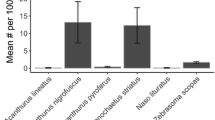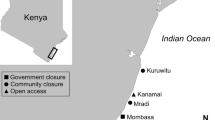Abstract.
Since the 1960s, and possibly earlier, the macroalga Dictyosphaeria cavernosa has overgrown and displaced corals on reef slopes and outer reef flats in Kaneohe Bay, Oahu. This shift in reef community composition is generally attributed to nutrient enrichment resulting from sewage discharge. Following the diversion of most of the sewage effluent in 1977–1978, it was expected that D. cavernosa growth would become nutrient-limited and its abundance would consequently decline, but the alga remains abundant in much of the bay. One explanation for its persistence is that nutrients are once again high enough to support the alga's growth. An alternative explanation is that there has been a reduction in grazing intensity in the bay. In this study we resurveyed the distribution and abundance of D. cavernosa at 120 reef slope sites originally surveyed in 1969. We conducted additional surveys to estimate the biomass of herbivores and the areal coverage of D. cavernosa and other macroalgae on reef slopes and flats. Field experiments were used to determine spatial and temporal patterns of grazing intensity on and growth rates of D. cavernosa and the introduced macroalga Acanthophora spicifera. Laboratory experiments were used to examine preferences among herbivores for some of the most abundant macroalgae on Kaneohe Bay reefs. Twenty years after sewage diversion, D. cavernosa cover on reef slopes has decreased substantially in southern Kaneohe Bay, the site of most of the historical sewage discharge. D. cavernosa cover has changed less in other regions, remaining high in the central bay and low in the north bay. D. cavernosa thalli protected by grazer exclusion cages sustained positive growth rates on reef slopes and flats throughout the bay. Reduced nutrient concentrations may have caused a reduction in D. cavernosa growth rates, and a consequent reduction in D. cavernosa abundance in the south bay shortly after sewage diversion. Measurements of grazing intensity and surveys of herbivorous fish abundance suggest that the continued abundance of D. cavernosa is the result of a reduction in grazing intensity. Reduced grazing intensity on D. cavernosa may in turn be the result of a historical reduction in herbivore biomass or the establishment of several introduced macroalgae on reef flats. The introduced species are preferred by herbivorous fishes over D. cavernosa, as indicated by preference tests. The hypothesis that reduced grazing pressure on D. cavernosa is related to the establishment of introduced species is supported by the observation that D. cavernosa cover is highest on reef slopes where the cover of preferred introduced macroalgae on the adjacent outer reef flat is also high. Conversely, D. cavernosa cover is low or zero on reef slopes where the cover of introduced macroalgae on the adjacent reef flat is low or zero
Similar content being viewed by others
Author information
Authors and Affiliations
Additional information
Electronic Publication
Rights and permissions
About this article
Cite this article
Stimson, J., Larned, S. & Conklin, E. Effects of herbivory, nutrient levels, and introduced algae on the distribution and abundance of the invasive macroalga Dictyosphaeria cavernosa in Kaneohe Bay, Hawaii. Coral Reefs 19, 343–357 (2001). https://doi.org/10.1007/s003380000123
Accepted:
Published:
Issue Date:
DOI: https://doi.org/10.1007/s003380000123




